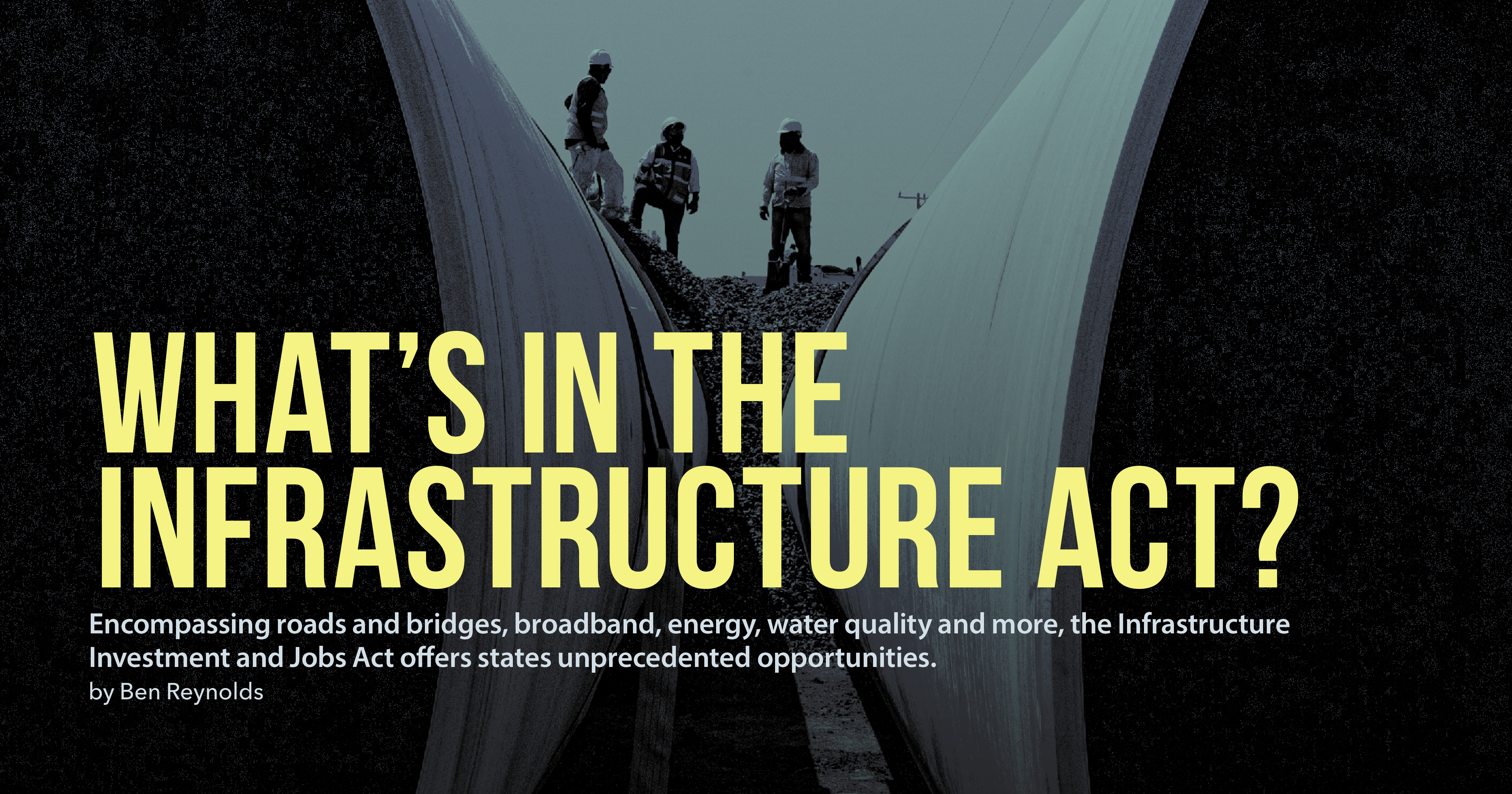
Passed on Nov. 15, 2021, the Infrastructure Investment and Jobs Act contains $1.2 trillion in spending, $550 billion of which is new federal spending while the remaining $650 billion comes from reallocation from other federal programs or from past funding sources. State leaders have access to this new funding focused on transportation, broadband, cybersecurity, energy, environment and disaster response. As policymakers prepare for an influx of cash, CSG offers ongoing fiscal analysis and resources for understanding federal spending.
Funds from the infrastructure act will be disbursed primarily through formula grants and competitive grants. Formula grants are non-competitive allocations in which disbursements are based on a predetermined formula set by legislation and regulations. Formula grants are a common way federal funds are given to state agencies and state-run projects. Competitive grants are awarded based on the merits of the project. These funds are allocated at the discretion of agencies charged with disbursement.
States own and maintain the vast majority of the roads and bridges throughout the country, including the interstate highway system. In fact, states maintain around one million miles of streets and highways that account for 85% of vehicle travel miles. The U.S. Department of Transportation has determined that 21.8% of roads are in poor condition and 7.6% of bridges need to be repaired or replaced. States often rely on federal funding to assist in funding costly road and bridge projects. The infrastructure act funds (or creates various programs to administer funds for) critical infrastructure.
Roadway Repair and Maintenance
To help states fund roadway projects, the infrastructure act reauthorizes the Surface Transportation Block Grant Program for another four years. The Surface Transportation Block Grant Program contains $72 billion in formula grants to be distributed to state transportation departments. The infrastructure act expands the scope of eligible activities for which states can use these block grant funds to include the creation and operation of a state office to oversee public-private partnerships that can receive federal highway or transit funding. States also can use Surface Transportation Block Grant Program funds to cover project administrative costs. The federal share for any project is 90% for a project on an interstate highway and 80% for any other projects. Funds will be released to state transportation departments in October 2022.
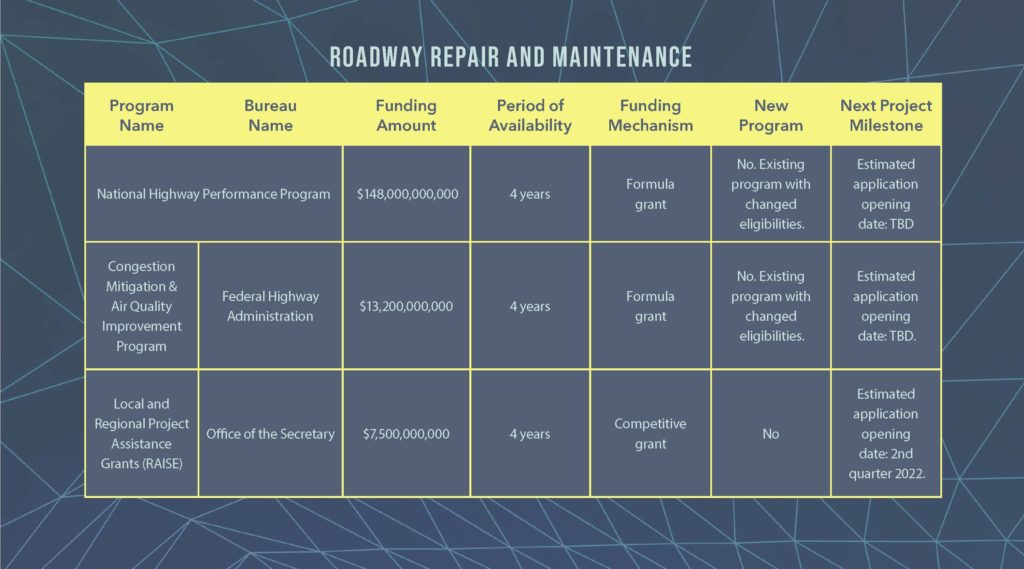
Bridge Repair and Maintenance
The infrastructure act allocates approximately $40 billion to the Federal Highway Administration for bridge projects. A new $12.2 billion competitive grant program, the Bridge Investment Program, allows states to apply for a grant to replace or repair bridges on the National Bridge Inventory. For example, Kentucky and Ohio are jointly applying for funding through the Bridge Investment Program to replace the Brent Spence Bridge, which spans the Ohio River. The Federal Highway Administration is also administering roughly $27 billion over four years to state transportation departments through the Bridge Formula Program. This new program provides formula funding to states for bridge replacement, rehabilitation, preservation, protection or construction projects on public roads.
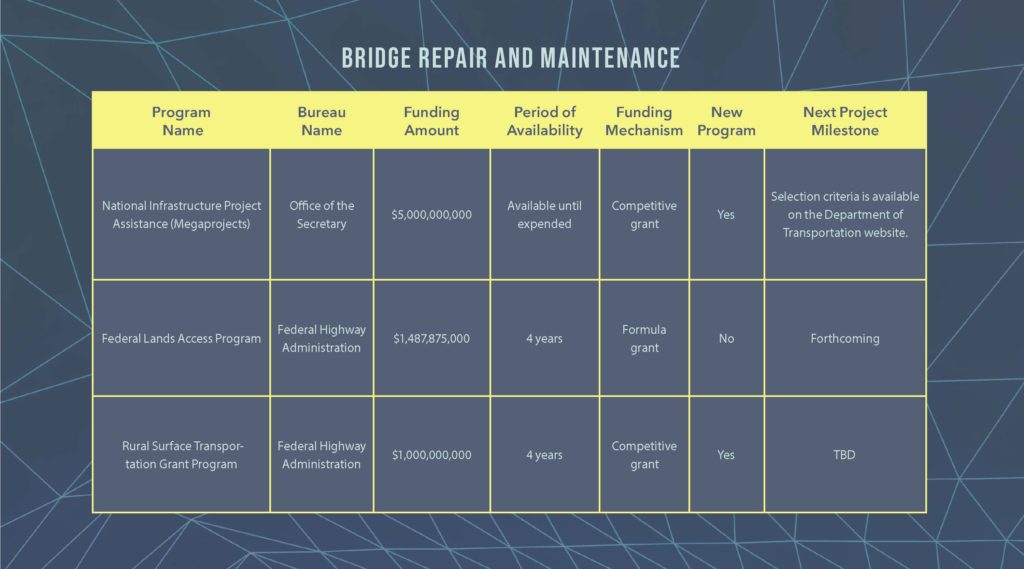
Railway Repair and Maintenance
The infrastructure act is also investing $66 billion in advanced appropriations over four years to improve the nation’s passenger and freight rail networks. These programs will modernize the Northeast Corridor (stretching from Washington, D.C., to Boston), expand passenger rail outside of the corridor, improve rail safety and upgrade freight rail infrastructure.
State and local governments face an estimated $105 billion repair backlog on public transportation systems. To reduce the backlog through funding capital projects, the Federal Railroad Administration is administering $36 billion in competitive grants through the heavily revised Federal-State Partnership for Intercity Passenger Rail Grants. Revised to expand the list of eligible projects outside the Northeast Corridor, this program funds capital projects to reduce the backlog and improve intercity passenger rail. An additional $7.5 billion is authorized contingent on future appropriations. In 2020, Connecticut used approximately $29 million of the Federal-State Partnership for Intercity Passenger Rail Grants to rehabilitate and upgrade platform and track areas of the Worcester Union Station.
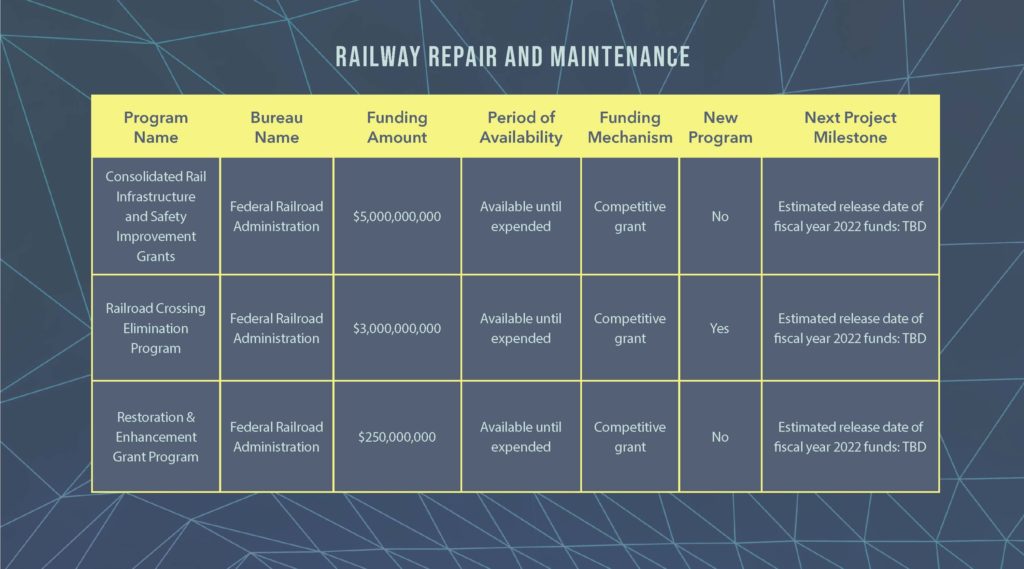
Public Transportation Repair and Maintenance
To further ensure systems repair will occur, the Federal Transit Administration is administering $91 billion in new and existing programs. States can use these funds to support efforts in repairing and modernizing public transportation while also expanding public transportation options. The infrastructure act reauthorizes the State of Good Repair Grants for over four years. The FTA will disburse roughly $21 billion in formula grants to state and local transportation departments for designated projects. The FTA will match up to 80% of the cost of capital projects that bring fixed guideway systems and equipment into a state of good repair. The infrastructure act also adds a competitive grant component, contingent on future appropriations, for states to fund projects to replace rail rolling stock (locomotives, freight cars and flat cars)
State transportation agencies can also compete for funds from a new competitive grant — the Capital Investment Grant Program — for projects on the hundreds of miles of “fixed guideways” in need of repair or replacement. Fixed guideway refers to public transportation systems that use right-of-way or rail lines exclusively for public transportation. This can include light rail, ferries and bus rapid transit. Eligible projects under the program are Small Starts and New Starts, corridor-based projects and intercity rail/public transportation projects. Small Starts are fixed guideway projects costing less than $400 million and seeking less than $150 million from the Capital Investment Grants. New Starts are fixed guideway projects with more than $400 million in costs and seeking more than $150 million in Capital Investment Grants funding. The maximum share that the Capital Investment Grants Program can cover is 80%, except for New Starts projects where the share is 60%. Projects must have a degree of local commitment with evidence of stable financing sources. Houston’s Metropolitan Transit Authority is preparing to implement a 25.3-mile bus rapid transit line across Houston. The project is estimated to cost $1.56 billion with 60% ($936 million) coming from the Capital Investment Grant program.
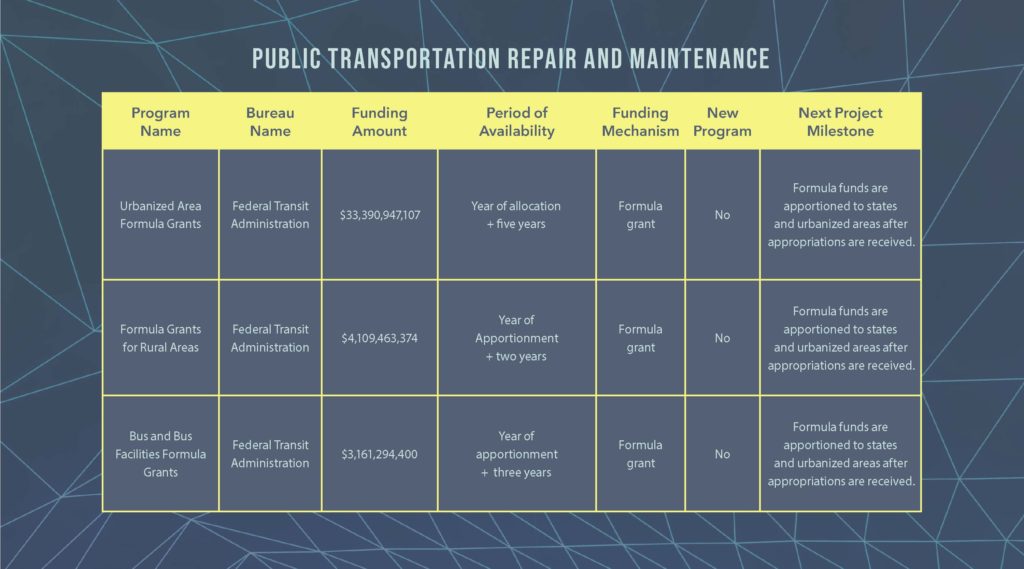
Roadway Safety
The United States has one of the highest traffic fatality rates in the industrialized world. An estimated 38,680 people died in motor vehicle crashes in 2020, of which 6,236 were pedestrians. Motor vehicle crashes were up 18% in the first half of 2021 over 2020. To help states improve the safety of their transportation systems, the infrastructure act is investing nearly $38 billion toward safety projects. States will continue to receive formula grants through the Highway Safety Improvement Program. The Federal Highway Administration is dispensing approximately $15 billion over four years to states for safety projects on public roads. State transportation departments must use a data-driven process when selecting highway safety improvement projects. Projects should be selected based on crash experience, crash potential, crash rate or other data-supported means. The second round of funding will be released in October 2022. The state of Washington received $26 million in Highway Safety Improvement Program funds, and in 2019, 70% of such funds were used to fund local safety projects. One such project was to design safer slopes on lane departures in Adams County.
The Federal Railroad Administration is authorized to expend $3 billion in funds through the Railroad Crossing Elimination Grant program. These competitive grants will allow states to improve highway-rail or pathway-rail crossings. Eligible projects under the program include grade separation or closure, track relocation and installation of protective signals and signs. Funding for Fiscal Year 2023 will be released in October 2022.
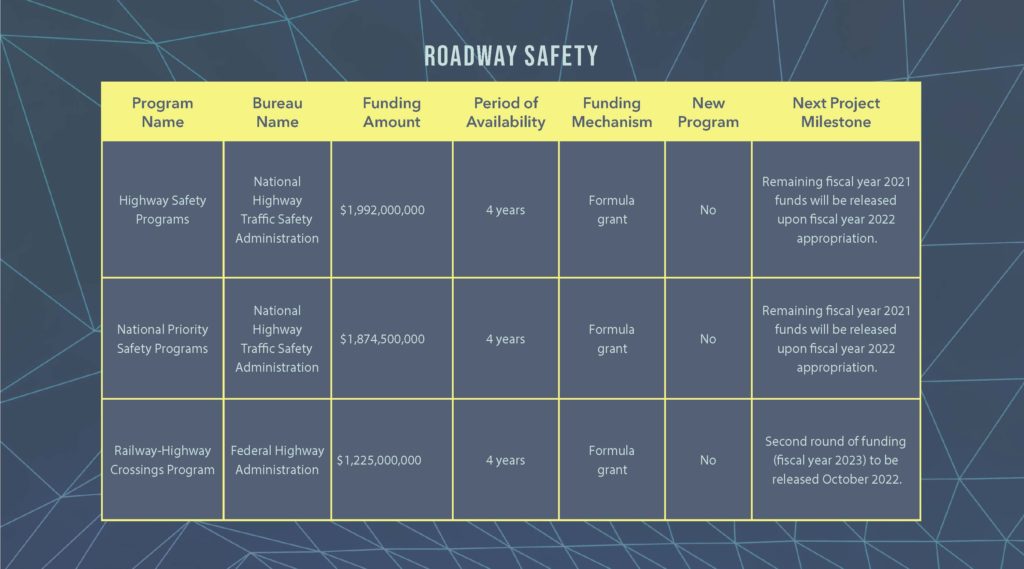
Air and Water Transportation
The infrastructure act also invests in America’s airports, ports and waterways, allocating $25 billion for repair and maintenance needs, reduction of congestion and emissions and the modernization of the National Aerospace System. An additional $16.7 billion is dedicated to projects that improve infrastructure at coastal ports, inland ports and waterways and land ports of entry along the border.
Airport Infrastructure Grant funds totaling $15 billion over five years are available to states that own an airport belonging to the National Plan of Integrated Airport Systems. The Federal Aviation Administration will issue a notice of funding for competitive $20 million annual grants for traffic control tower construction and maintenance in May 2022.
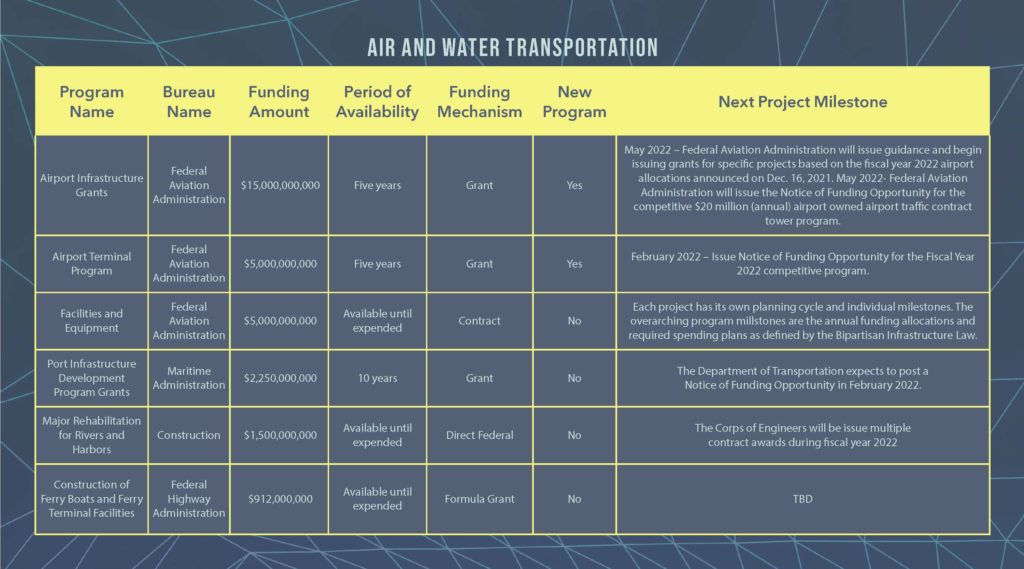
Broadband
The pandemic has accelerated the need for broadband access for essential functions including school, work and access to health care. However, approximately 30 million people live in areas with either no broadband infrastructure or unacceptable minimum internet speeds. Internet access is especially lacking in rural areas. The Infrastructure Investment and Jobs Act is investing $65 billion in new and existing programs that expand broadband infrastructure and assist in lowering internet prices. The National Telecommunications and Information Administration is administering $42 billion through the Broadband Equity, Access, and Deployment Program. Created by the infrastructure act, states and Puerto Rico will each receive a minimum of $100 million in funds while the remaining territories will each receive a minimum of $25 million for broadband planning, deployment and adoption projects. The remaining funds will be distributed based on a formula that considers the number of unserved and high-cost locations in the state based on maps to be published by the Federal Communications Commission.
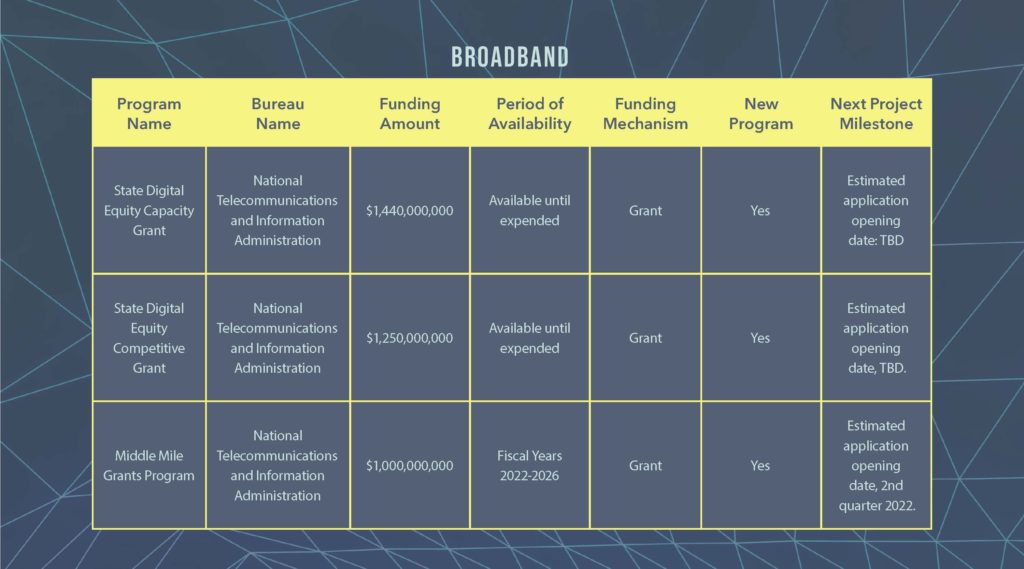
Energy
The Infrastructure Investment and Jobs Act makes significant investments in projects to improve the nation’s energy infrastructure and environmental resilience. Many of these projects will require significant cooperation by and among states. The infrastructure act provides approximately $75 billion toward energy projects, $21.3 billion of which will go to energy infrastructure that delivers clean energy and $21.5 billion for clean energy demonstration projects like clean hydrogen and advanced nuclear reactors. States are required to engage public-private partnerships. An initiative called Program Upgrading Our Electrical Grid and Enduring Reliability and Resiliency makes available $5 billion in funding through cooperative agreements or grants. These grants are to facilitate regional grid resilience through partnerships among utility owners and operators and states with utility cooperatives. A combination of two or more states, local governments and/or public utility companies are the intended recipients of the funds, which will be available in the fourth quarter of 2022.
To help states reduce carbon emissions, the Environmental Protection Agency is providing grants, rebates or contracts through the newly established Clean School Bus Program. Approximately $5 billion over five years will be allocated to state agencies to replace school bus fleets with low and zero emission school buses.
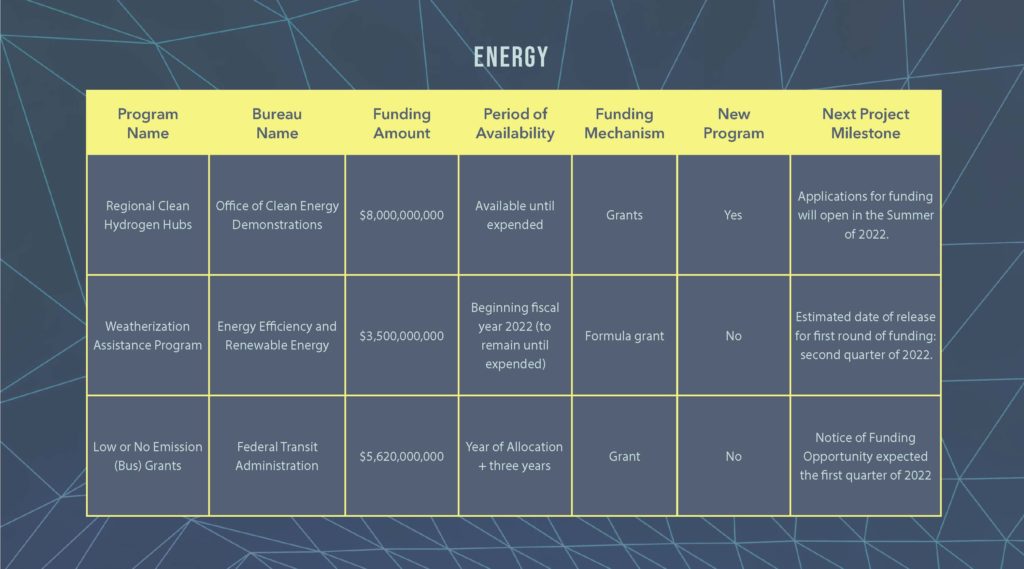
Water
Around 10 million households do not have access to clean drinking water. The infrastructure act provides $23 billion for states to establish Drinking Water and Clean Water State Revolving Fund programs. These funds will allow states to offer loans and grants to eligible entities for water projects. These water projects must focus on disadvantaged communities. The infrastructure act requires that 49% of Clean Water State Revolving Funds be eligible as grants or 100% of the funds be principal forgiveness loans. The Indianapolis Airport Authority received $30 million from Indiana’s State Revolving Fund Loan program in 2019 to install new stormwater and deicing runoff infrastructure.
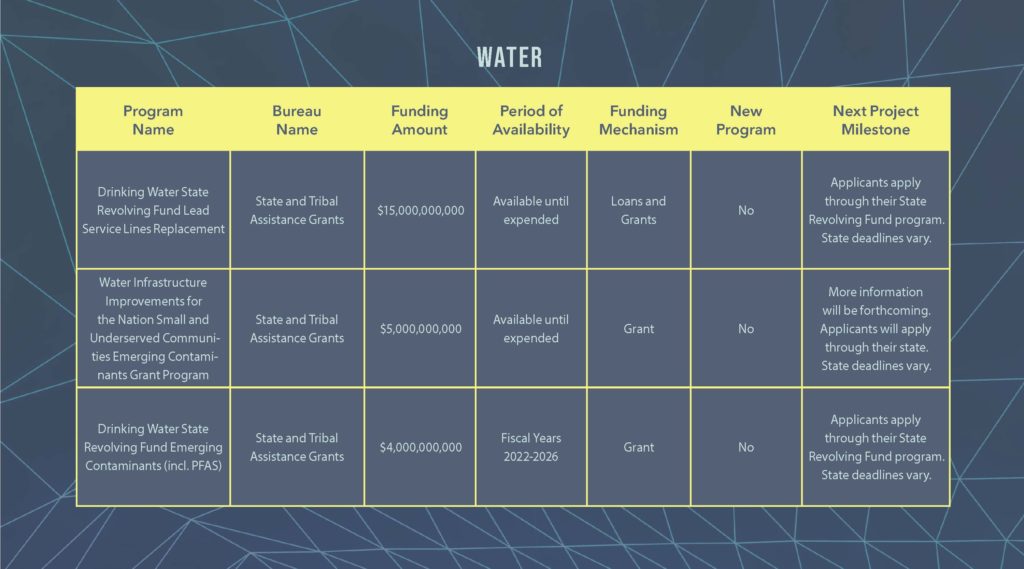
Resilience
To assist communities in responding to natural disasters and cyberattacks, the infrastructure act contains approximately $50 billion for programs that increase resilience. This includes $8.7 billion in grants from the Promoting Resilient Operations for Transformative, Efficient, and Cost Saving Transportation Grants program, which contains roughly $7.2 billion over four years in formula grants for states to conduct resilience planning and increase the resilience of surface transportation infrastructure from the impact of natural disasters. Another $1.4 billion in competitive grants is available over four years for states.
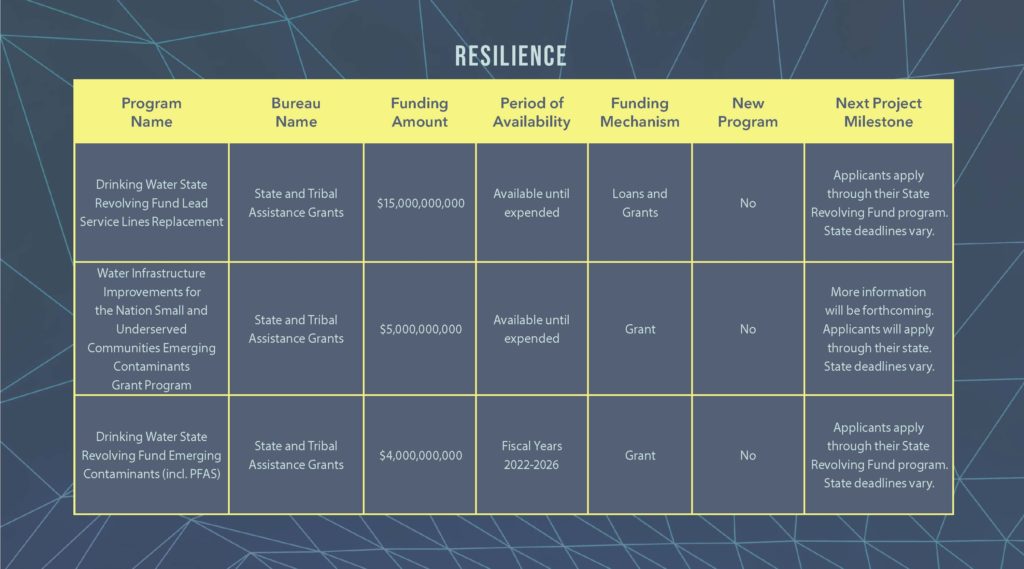
This article appeared in the CSG Capitol Ideas magazine (2022, Issue 2). View current and past issues at csg.org/publications/capitol-ideas.




